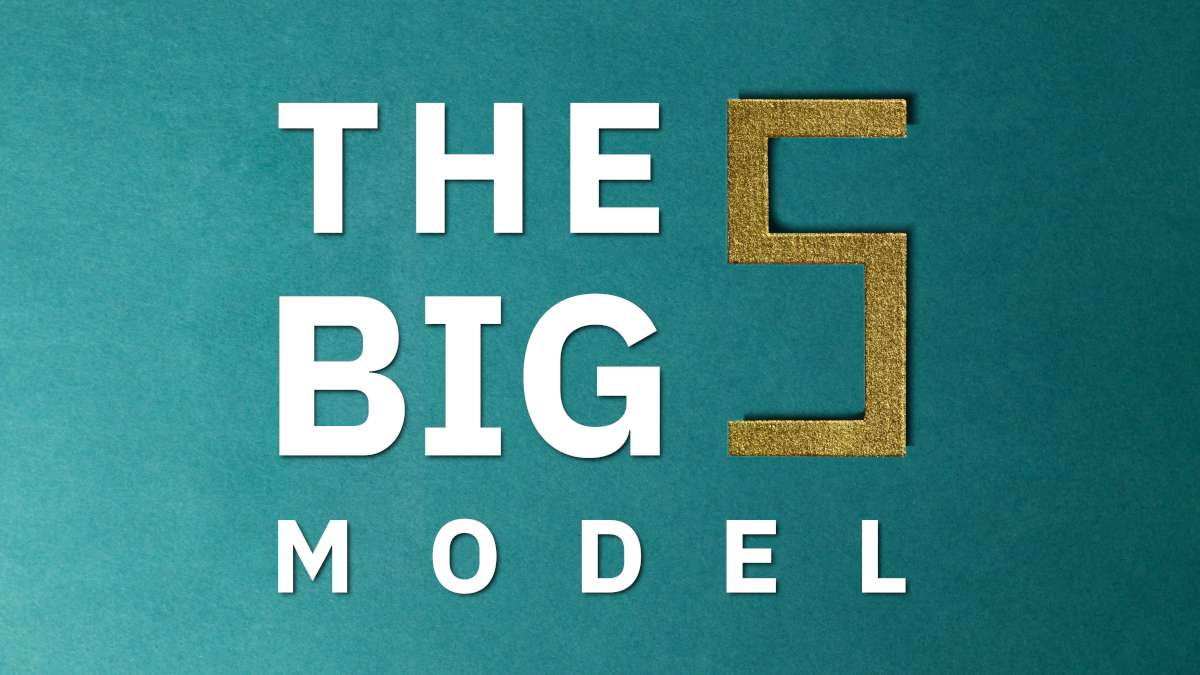The Big Five model, also known as the OCEAN model, is a personality traits classification theory that focuses on five fundamental personality factors. To answer the question ‘why OCEAN?’, the word is an acronym deriving from the initial letters of the words that describe these five factors that will be described in more detail, further on.
The Big Five model, or OCEAN model, is widely used in personality assessments to analyze correlated aspects in the character and disposition of a person — based, of course, on the aforementioned factors. Consequently, this method supports that each personality trait constitutes a range of semantically cohesive qualities.
For instance, to measure someone for extraversion vs. introversion using the Big Five method, one would place this person on a specific level on the extraversion – introversion spectrum. In this respect, a personality is not measured in terms of extremes, say, black and white; but rather in a broader perspective, perceiving each trait as a palette of similar hues.
Before looking at the Big Five personality traits, a brief historical reference would help discover when and how the Big Five or OCEAN model came to be.
The history behind the Big Five model
Although the Big Five model was formed in 1993 by the psychologist Lewis Goldberg, it actually began developing much earlier. In particular, a personality trait study conducted back in 1936 by Gordon Allport and his colleagues, shed light on 4,504 words that were — and still are — used to describe fixed personality traits.
The interesting part of their research was the realization that those words (adjectives and their synonyms) could be observed and measured within a personality. Following their work, other psychologists started researching characteristics that indicated the basic dimensions of a personality. Their study — along with the relative studies that followed — was based on Carl Jung’s conception of extraversion and introversion, as central personality traits.
In 1940, another psychologist, Raymond Cattell, formed a group of sixteen traits, based on Allport’s adjectives, which he named the 16PF Questionnaire. Decades later, in the ‘90s, a group of psychologists who studied Cattell’s questionnaire — among them, the renowned Lewis Goldberg — found that these traits could be narrowed down to five main aspects.
The model was later validated by other psychologists and was officially established as the Big Five model or OCEAN model — one of the most commonly used psychological theories.
What does the Big Five model do?
The Big Five model draws from the lexical hypothesis to describe the cluster of five key aspects that comprise the human personality or psyche. Practically, a psychologist, a researcher, or an HR manager can gain a good understanding of one’s personality; and, even predict certain behaviors that pertain to one’s scores on the Big Five personality traits.
By reducing the guesswork during the hiring process, a recruiter can match any job position to its ideal candidate. In addition, an HR manager can use the Big Five or OCEAN model to recommend improvements or enhancements to the culture of a company.
The Big Five or OCEAN model personality traits
1. Openness
People who score high on this trait are intellectually curious and imaginative. They are not afraid to experience a variety of new things, to explore unknown places. In fact, they are more likely to experiment with unconventional ideas and to express themselves emotionally and artistically.
Conversely, those who score low are more reserved and realistic. They are creatures of habit, who like to maintain routines and stick to what they know. Matter-of-factly as they are, they feel safe with numbers and data — anything they can calculate and quantify.
2. Conscientiousness
Those who score high in this factor are efficient, organized, and prudent. They have a strong sense of duty; thus, are more capable of adapting to tackle challenges. Also, they tend to be in control of their impulses, which indicates self-discipline and maturity.
On the other side of the spectrum, those who present low conscientiousness scores are disorganized, impulsive, extravagant, temperamental, and somewhat unreliable. Moreover, they are prone to procrastination, depression, and, in some cases, substance abuse.
3. Extraversion
Extraverts are sociable, outgoing, assertive, energetic, and fun-loving. They are comfortable with others, and feel revitalized from human interaction; besides, that’s what extraversion indicates: where one draws energy from, and how they direct it (outwardly or inwardly).
So people who are rated low on extraversion, usually feel drained from social interaction; hence, they seek to replenish their energy in solitude. More often than not, they tend to be quiet, low-key, introspective, thoughtful, and taciturn. Usually, they like to keep their opinions and views to themselves, and are discreet.
4. Agreeableness
According to psychometric analysis, having positive relationships is an indication of a high agreeableness score. People that score high on this factor are altruistic, warm, and compassionate; also, they’re concerned for the welfare of others. What’s more, they freely express gratitude, they are generous, forgiving, trusting and trustworthy.
Those on the low end of the agreeableness spectrum, tend to concern only for themselves, they are aloof, unapproachable, and suspicious of the motives of others; consequently, they don’t cooperate easily — nor smoothly. Although not all disagreeable people are blunt or rude, they are likely to be perceived as cold and unfriendly.
5. Neuroticism
Neuroticism encompasses one’s emotional stability and general temper. To be more precise, it indicates how comfortable someone is in her/his own skin. People who score high in this trait are prone to experience negative emotions; such as anxiety, melancholy, worry, nervousness, pessimism, and anger. They tend to be very sensitive, self-conscious, emotionally reactive, and they display low self-esteem.
At the other end of the scale, those who score low in neuroticism are calm, stable, more confident, and resilient. However, this doesn’t mean that low-scorers constantly experience positive emotions; they too may be encumbered by worry or self-doubt — they’re only human, after all.
Neo subfacets: Delving deeper in the Big Five personality traits
Having validated Goldberg’s model, two psychologists, Paul Costa Jr. and Robert McCrae, conducted further research on the Big Five theory, which resulted in an enhanced personality inventory.
They called this inventory the NEO PI manual, in which they developed sub-traits or subfacets for each Big Five personality trait. In the years that followed, having more norms data on their hands, they revised the NEO PI, creating two updated versions of it, the NEO PI-R, and the NEO PI-3.
As mentioned, Costa and McCrae introduced facet scales for each trait in the Big Five or OCEAN model. A facet, in terms of psychology, is a specific aspect of a broader personality trait.
The two psychologists connected each of the Big Five traits with six linguistically relevant subfacets. Those subfacets or sub-traits help experts clearly define someone’s score upon a trait.
| Openness NEO subfacets | ConscientiousnessNEO subfacets | ExtraversionNEO subfacets | AgreeablenessNEO subfacets | NeuroticismNEO subfacets |
| Actions | Achievement striving | Activity | Altruism | Angry hostility |
| Aesthetics | Competence | Assertiveness | Compliance | Anxiety |
| Fantasy | Deliberation | Excitement-seeking | Modesty | Depression |
| Feeling | Dutifulness | Gregariousness | Straightforwardness | Impulsiveness |
| Ideas | Order | Positive emotions | Tender-mindedness | Self-consciousness |
| Values | Self-discipline | Warmth | Trust | Vulnerability |
How does the Big Five model measure personality traits?
The Big Five or OCEAN personality traits are typically assessed through a personality inventory, in the form of words or self-descriptive sentences; often using the IPIP collection, managed by the Oregon Research Institute.
While the items contained in the questionnaires vary in the exact terms that correspond to each trait, they essentially delineate the same dimensions, including their subfacets. Ordinarily, a Big Five test consists of fifty items, requiring the person who takes the test to rate each statement, based on how true or untrue they are about themselves.
To illustrate, the test provides high-to-low scores on each trait on the Likert scale, which is a five-point psychometric system where the individual states the level of their agreement or disagreement for each statement; for example, 1=Strongly Disagree, 2= Disagree, 3=Neutral, 4=Agree, and 5=Strongly Agree.
Typically, the Big Five or OCEAN personality assessment takes 3-8 minutes to complete, depending on how many items it contains. Finally, an average score is calculated for each of the five traits, based on an individual’s ratings on these statements.
Why is the Big Five or OCEAN model an important assessment tool for companies?
So many companies, nowadays, assess candidates for a job based on the Big Five personality traits; not by chance. The Big Five or Ocean model shows consistency in different measurement methods; and it retains this consistency across cultures and age ranges. As such, HR specialists consider it a reliable assessment system.
Another factor that makes the Big Five model an important personality evaluation tool is the fact that the personality traits it focuses on seem to remain stable throughout an individual’s lifetime.
For this reason, it can be used to explore the connections between personality and consequential life indicators or outcomes — including physical health, education, as well as profession.
Using scores to match people to work roles
It is not rare for an HR professional to recruit people who, although had the necessary skill-set, didn’t perform well in their role; or, even couldn’t blend well with the existing team.
It is a fact that when a personality doesn’t fit the role to which it is assigned, it can be detrimental for everyone involved. The person who has the ‘misfit’ personality will end up feeling unproductive and, eventually, unhappy; whereas, the company is made vulnerable to decreased productivity, and increased team turnover — among other things.
For instance, a reserved and quiet person is not likely to perform well in a sales position, since it’s an activity that requires assertiveness and high levels of energy. In like manner, a person who’s impulsive and unorganized will probably not be a good fit for bookkeeping or legal jobs.
The Big Five or OCEAN model can help address these issues. Recruiters can use it accordingly to spot the right people for the right job; meaning, they can hire people who have both the personality and the skills to shine in their assigned work role.
The previously mentioned correlations between personality traits and work-related outcomes, are key to make the required match. To elaborate, researchers have found that:
- Openness is positively related to individual proactivity and leadership qualities; however, it is negatively related to team efficiency.
- Conscientiousness is considered the strongest indicator of all Big Five traits for high job performance, and a high salary.
- Extraversion is a good indicator for sales and management positions, although negatively connected to job performance.
- Agreeableness indicates better performance in jobs that require teamwork and adaptivity; however, it doesn’t relate positively to proactivity and salary.
- Neuroticism is positively linked to intelligence, prevention, and provision; yet, negatively associated with job performance, leadership, and salary.
TL;DR
In psychometrics, personality traits is a complicated and sensitive field of research; this explains why it displays a long history of discarded theories. The Big Five model, however, is one of those theories that matured over the years, and even got enriched with the knowledge offered by a plethora of researchers that found value in it.
The Big Five or OCEAN model can help a psychologist or an HR professional probe into a personality; that is, whether they use the Big Five Inventory, the NEO PI-R, or something else entirely. That way, they can help people to get to know their strengths and, thus, leverage them effectively; also, to become aware of their weaknesses, accept them, and work towards becoming the best version of themselves.



